Cheesy Cauliflower Rice: Your Ultimate Low-Carb, Keto-Friendly Side Dish
Embrace a healthier, low-carb lifestyle without sacrificing flavor with our incredible Cheesy Cauliflower Rice. This dish is a revolutionary alternative to traditional white rice, perfect for those following keto, grain-free, or gluten-free diets, yet so delicious it appeals to everyone. We harness the rich, savory, and irresistible umami notes of grated Parmesan cheese to transform humble cauliflower into a culinary delight. Whether you prefer the hands-on approach with a box grater, the speed of a food processor, or the convenience of store-bought pre-riced cauliflower, our guide will help you create a perfectly seasoned and satisfying side. It’s not just for dinner; leftovers reheat beautifully for quick, healthy lunches, making meal prep a breeze.
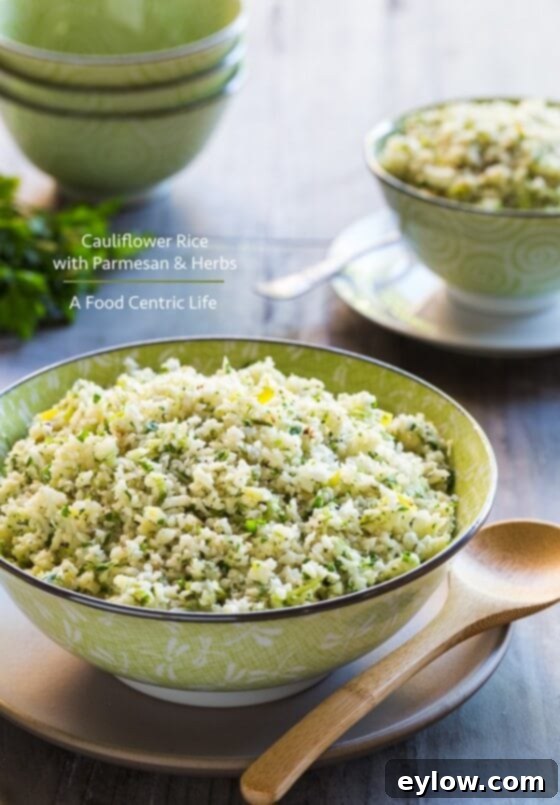
Why Choose Cheesy Cauliflower Rice?
In the quest for healthier eating, cauliflower rice has emerged as a superstar, and for good reason. It offers an incredibly versatile and nutritious swap for carb-heavy grains, making it a staple for anyone looking to reduce their carbohydrate intake. When you add a generous sprinkle of Parmesan cheese, you elevate this simple vegetable to a rich, comforting side dish that’s bursting with flavor. Parmesan delivers that sought-after savory depth and a delightful texture that complements the tender cauliflower perfectly. It’s a smart choice for maintaining stable blood sugar levels, boosting vegetable intake, and enjoying truly delicious food that aligns with your dietary goals.
Beyond its low-carb appeal, cauliflower itself is a nutritional powerhouse, packed with vitamins, minerals, and antioxidants. It’s an excellent source of Vitamin C, Vitamin K, and B vitamins like folate, crucial for overall health. The fiber content supports digestive health, and its anti-inflammatory compounds contribute to well-being. By opting for cheesy cauliflower rice, you’re not just making a dietary adjustment; you’re making a significant upgrade to your plate, providing essential nutrients while savoring a dish that feels indulgent.
[feast_advanced_jump_to]
Preparing Cauliflower Rice: Food Processor or Hand Grater
Creating your own cauliflower rice at home is simpler than you might think and often results in a fresher, more flavorful product than store-bought versions. You have two main tools at your disposal: a food processor or a classic hand box grater. Both methods yield excellent results, allowing you to control the texture of your “rice.”
If you’re wondering which tool is best for the job, consider your kitchen setup and how often you plan to make cauliflower rice. A food processor is undoubtedly faster and more efficient, especially if you’re preparing larger batches. However, a sturdy box grater is a reliable, low-tech alternative that works perfectly well and requires minimal cleanup. Regardless of your chosen method, raw, grated cauliflower can be stored in an airtight container in the refrigerator for a few days, making it ideal for meal prepping and quick weeknight dinners.
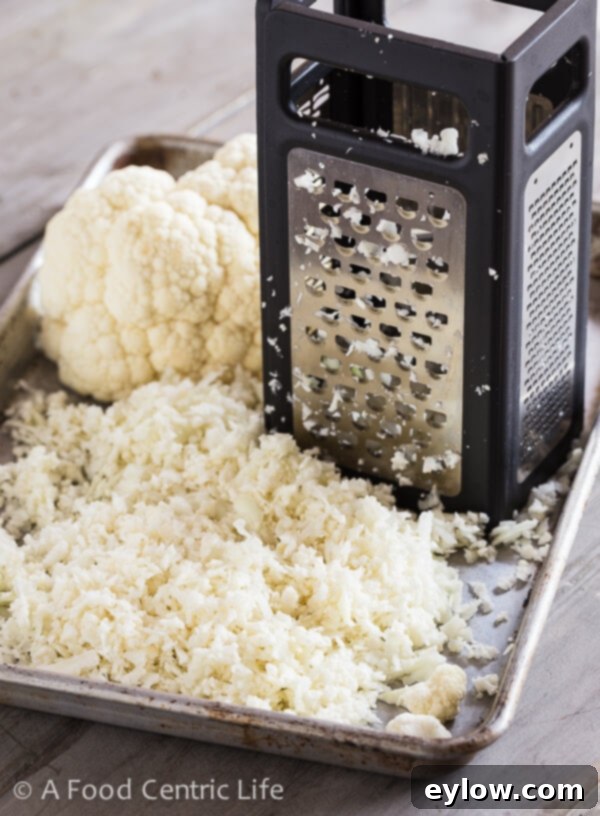
Box Grater Instructions for Cauliflower Rice
Using a box grater is a straightforward and effective way to make cauliflower rice, especially if you don’t own a food processor or prefer a slightly coarser texture. Begin by preparing your head of cauliflower: first, remove all the tough green outer leaves. Then, thoroughly wash the cauliflower head under cool water. With a sharp knife, carefully trim out the hard core. For easier handling when grating, cut the cauliflower head into halves or quarters. Larger pieces provide a better grip and reduce the risk of grating your knuckles.
Position your box grater over a cutting board, a large mixing bowl, or a rimmed baking sheet. This helps to contain all the “rice” as it falls, minimizing mess. Use the side of the grater with the large holes – this will produce a texture similar to traditional rice grains. Grate the cauliflower firmly, moving it across the holes until you’ve processed all the pieces. You’ll be amazed at how quickly you can transform a whole head of cauliflower into a fluffy pile of rice!
Food Processor Instructions for Cauliflower Rice
For those seeking speed and consistency, a food processor is the ultimate tool for making cauliflower rice. This method is particularly useful when preparing larger quantities or if you desire a finer, more uniform “rice” texture. Start by breaking your trimmed cauliflower head into manageable florets. The size isn’t critical, as the food processor will do the heavy lifting, but aim for pieces that fit comfortably into the feed tube.
Fit your food processor with the grating disk, typically the one with larger holes, which is perfect for creating the initial rice-like texture. Add the cauliflower florets into the feed tube. With the processor running, push the florets down using the pusher. You can use either the large or small feed tube, depending on the size of your florets and your preference for control. Once grated, replace the grating disk with the standard S-blade (steel knife). Pulse the grated cauliflower just a few times. This crucial step helps to break down any larger pieces into a finer, more consistent “rice” texture, closely mimicking the grain. Be careful not to over-process, as this can turn your cauliflower into a mushy paste rather than distinct rice grains.
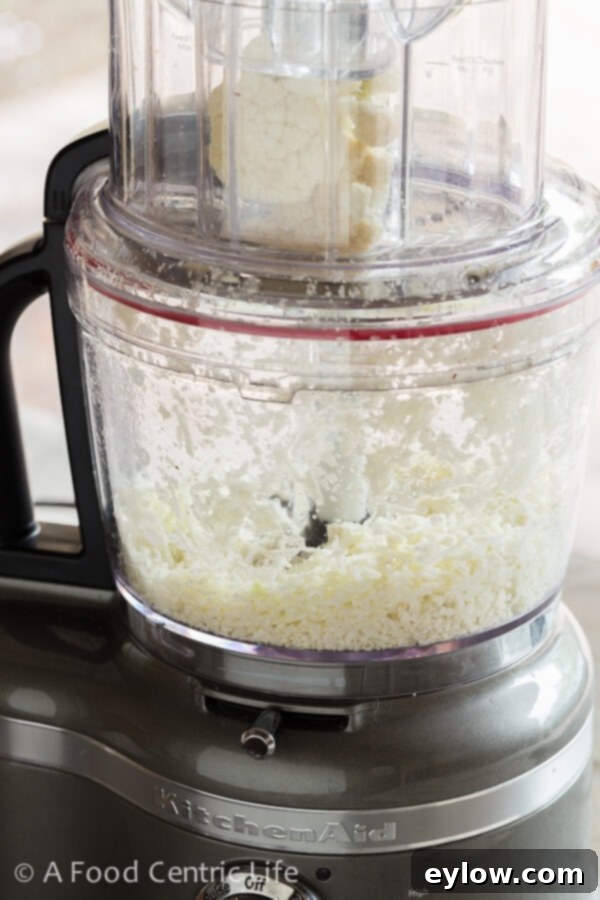
The Art of Cooking Cheesy Cauliflower Rice
Cooking cauliflower rice is a quick and satisfying process that brings out its natural sweetness and prepares it to absorb all the delicious flavors you’ll add. The key is to avoid overcooking, which can lead to a watery or mushy texture. Aim for tender-crisp, much like perfectly al dente rice. Start by heating your choice of healthy fat – olive oil, avocado oil, or coconut oil – in a 3-4 quart sauté pan or a 12-inch frying pan over medium heat. The pan size is important; you want enough surface area for the cauliflower to cook evenly without steaming.
Once the oil is shimmering, it’s time to build flavor. I highly recommend adding aromatics like thinly sliced shallots, finely chopped leeks, or diced onions. Sauté these gently until they soften and become translucent, which typically takes about 2-3 minutes. This step creates a beautiful flavor foundation. Next, add minced garlic and cook for another minute, stirring constantly to prevent it from burning. The fragrant aroma of sautéed aromatics and garlic will instantly elevate your cauliflower rice. Finally, add the prepared cauliflower rice to the pan, season generously with salt and pepper, and cook for about 5-7 minutes, stirring occasionally, until it’s heated through and tender-crisp. The entire cooking process, from aromatics to finished rice, takes approximately 10 minutes, making it an ideal choice for busy weeknights.
Elevate Your Cheesy Cauliflower Rice: Flavor Variations
While plain cheesy cauliflower rice is delightful on its own, its mild flavor profile makes it an excellent canvas for culinary creativity. You can transform it to complement almost any meal, simply by adding a few key ingredients. For an extra pop of color and freshness, always finish with freshly chopped herbs. Here are some exciting variations to keep your meals interesting and delicious:
- Cilantro-Lime Cauliflower Rice: Perfect as a vibrant side for Mexican-inspired dishes like tacos or fajitas. After cooking, stir in a generous amount of fresh chopped cilantro and a squeeze of fresh lime juice. A pinch of chili powder can add a subtle kick.
- Mediterranean Cauliflower Rice: Transport your taste buds to the Mediterranean by adding finely chopped fresh basil, oregano, rosemary, or chives. Consider tossing in some Kalamata olives, sun-dried tomatoes, or crumbled feta (if dairy is part of your diet) for a truly authentic experience.
- Indian-Spiced Cauliflower Rice: For an aromatic and flavorful Indian-inspired dish, infuse the hot oil at the beginning of the cooking process with a little curry powder, turmeric, and perhaps a tiny pinch of saffron. Finish with fresh coriander (cilantro). You can also stir in some cooked peas for color and sweetness.
- Asian-Inspired Cauliflower Rice: Give your rice an Asian twist by adding a splash of soy sauce or tamari, a drizzle of toasted sesame oil, and a sprinkle of sesame seeds. You might also include some finely diced carrots and green onions.
- Hearty Mushroom & Pea Cauliflower Rice: Finely chopped and sautéed mushrooms add an earthy, umami depth, while vibrant green peas introduce a touch of sweetness and beautiful color. This combination makes for a more substantial side.
For this specific Cheesy Cauliflower Rice recipe, we recommend a simple yet effective combination of fresh Italian parsley and generous amounts of grated Parmesan cheese. The parsley adds a bright, herbaceous note that perfectly balances the rich, salty Parmesan. If you are following a dairy-free, vegetarian, or vegan diet, simply omit the Parmesan cheese; the cauliflower rice will still be incredibly flavorful, especially with the added aromatics and herbs. To enhance the texture and boost healthy fats and protein, consider stirring in a handful of toasted pine nuts, chopped walnuts, or cashews at the end. Their crunch provides a delightful contrast to the soft cauliflower and elevates the dish’s nutritional profile.
Nutritional Powerhouse: The Benefits of Cauliflower
Cauliflower is not just a versatile low-carb alternative; it’s also one of the healthiest vegetables you can incorporate into your diet. As a member of the cruciferous family, alongside its cousins like cabbage, kale, and broccoli, cauliflower is packed with an impressive array of nutrients that support overall health and well-being. It’s particularly celebrated for its high content of vitamins C and K, essential for immune function, collagen production, and blood clotting. Beyond these, cauliflower provides a healthy dose of B vitamins, including folate, which is crucial for cell growth and DNA synthesis.
Moreover, cauliflower is rich in phytonutrients, powerful plant-based chemicals that act as antioxidants and anti-inflammatory agents in the body. These compounds, such as glucosinolates and isothiocyanates, have been studied for their potential protective effects against various chronic diseases, including certain cancers. In addition to its vitamin and phytonutrient content, cauliflower offers a significant amount of potassium, which is vital for maintaining healthy blood pressure, and dietary fiber, which aids digestion, promotes satiety, and helps regulate blood sugar levels. Incorporating cauliflower rice into your meals is an intelligent and satisfying way to reduce higher-glycemic carbohydrates in your diet while simultaneously boosting your intake of crucial vitamins, minerals, and protective plant compounds.
Don’t limit yourself to just white cauliflower! Explore the vibrant orange, purple, and green varieties available. These colorful cultivars not only add visual appeal to your plate but often boast unique nutritional benefits. For instance, orange cauliflower is higher in Vitamin A, while purple cauliflower contains anthocyanins, powerful antioxidants also found in blueberries and red cabbage. Experimenting with these different colors can make your meals more exciting and further diversify your nutrient intake, proving that healthy eating can be both delicious and visually appealing.
Meal Prep and Delicious Leftovers
One of the fantastic benefits of Cheesy Cauliflower Rice is how wonderfully it holds up as leftovers. When I prepare a larger batch for recipe testing or for my family, I always make extra because I know it will be just as delicious the next day. Cooked cauliflower rice reheats quickly and maintains its excellent texture and flavor for several days in the refrigerator. This makes it an ideal component for healthy meal prep, saving you precious time during busy weeknights or lunch breaks.
Transforming leftovers into new meals is a breeze. A portion of reheated cheesy cauliflower rice makes a delightful and satisfying lunch on its own, or you can pair it with other leftover proteins. For example, add some shredded roast chicken for a complete and flavorful meal, or toss in some cooked shrimp for a quick seafood twist. You could even fold it into an omelet or frittata for a nutritious breakfast or brunch. The versatility of this dish ensures that you won’t get bored, and it truly helps minimize food waste while keeping you on track with your healthy eating goals. Its ability to be repurposed makes it a kitchen staple that keeps on giving.
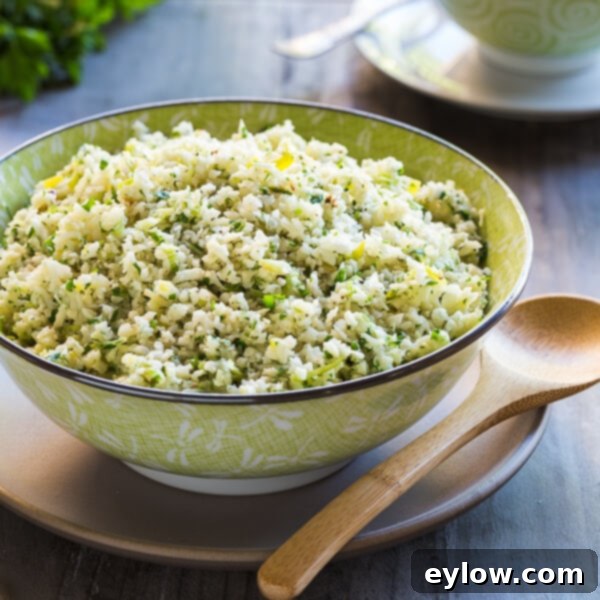
More Delicious Cauliflower Recipes to Explore
If you’ve fallen in love with the versatility and health benefits of cauliflower through this recipe, you’ll be thrilled to discover many other ways to enjoy this incredible vegetable. Cauliflower’s mild flavor and adaptable texture make it a star in a wide array of dishes, from creamy soups to hearty roasted sides. Here are some more inspiring cauliflower recipes to add to your culinary repertoire:
- Creamy Cauliflower Soup: A comforting and rich soup that’s surprisingly light and full of flavor.
- Cauliflower Puree: A silky smooth alternative to mashed potatoes, perfect for a low-carb side.
- Roasted Cauliflower Florets: Simple yet incredibly flavorful, with crispy edges and tender insides.
- Cauliflower Colcannon: A healthy, low-carb twist on the classic Irish dish, traditionally made with cabbage and mashed potatoes.
📖 Recipe
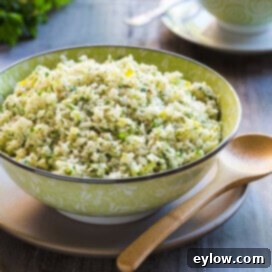
Cheesy Cauliflower Rice
Sally Cameron
Pin Recipe
Equipment
-
Food processor or box grater
Ingredients
Basic Cauliflower Rice
- 1 large head cauliflower about 1 ¾ pounds, yielding approximately 4 cups of riced cauliflower
- 1 tablespoon olive oil, avocado oil, or coconut oil
- 1 cup chopped leek, shallot or onion for aromatic flavor
- 3 garlic cloves finely chopped or minced
Optional Additions (Highly Recommended)
- ⅓ cup chopped fresh parsley leaves or other herbs (e.g., chives, basil, cilantro) for freshness and color
- ⅓ cup grated Parmesan cheese (or nutritional yeast for dairy-free/vegan option)
- ⅓ cup pine nuts or other nuts (2 ounces, e.g., chopped walnuts or cashews, toasted for extra crunch)
- Salt and pepper to taste, essential for seasoning
Instructions
Preparing Cauliflower Rice with a Box Grater
-
To prepare your cauliflower for ricing, first remove all the green outer leaves from the head. Then, carefully cut out the tough core using a sharp knife. If you are using a box grater, cut the cauliflower head into manageable quarters. Grate these pieces on the large-hole side of the grater directly onto a cutting board or into a rimmed baking sheet to catch all the “rice.”
Preparing Cauliflower Rice with a Food Processor
-
If you’re using a food processor, break the prepped cauliflower head into small florets that fit easily into the feed tube. Equip your food processor with the grating blade that has large holes. With the processor running, push the florets through the feed tube. Once all the cauliflower is grated, replace the grating blade with the steel S-blade (regular chopping blade) and pulse the grated cauliflower just a few times until it reaches a finer, uniform rice-like consistency. Be careful not to over-process, as it can quickly turn into a paste.
To Cook Your Cheesy Cauliflower Rice
-
Heat your chosen oil (olive, avocado, or coconut) in a medium-sized (3-4 quart) sauté pan or a 12-inch frying pan over medium heat. Once the oil is hot and shimmering, add the chopped leek, shallot, or onion. Reduce the heat to medium-low and cook, stirring occasionally, until the aromatics are softened and translucent, which should take about 2-3 minutes. Next, add the finely chopped garlic and continue to cook for just 1 minute more, stirring constantly to prevent burning.
-
Increase the heat back to medium. Add the prepared cauliflower rice to the pan and season generously with salt and freshly ground black pepper. Cook the cauliflower, stirring frequently, until it is heated through and tender-crisp. This typically takes about 5-7 minutes. Ensure it doesn’t become overly soft or watery.
Optional: Ways to Dress Up and Flavor Your Cauliflower Rice
-
Once the cauliflower rice is cooked, remove it from the heat. To enhance its flavor and add a beautiful touch of color, stir in the grated Parmesan cheese and fresh chopped herbs (like parsley, chives, or basil). For an added layer of texture and healthy fats, sprinkle in some toasted pine nuts or other chopped nuts. Feel free to get creative with other seasonings and additions based on your preferences!
